
Crop rotation is the practice of growing a series of different types of crops in the same area across a sequence of growing seasons. It reduces reliance on one set of nutrients, pest and weed pressure, and the probability of developing resistant pests and weeds.
The following outline is provided as an overview of and topical guide to agriculture:
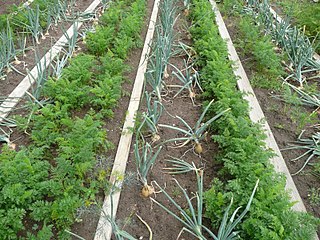
Companion planting in gardening and agriculture is the planting of different crops in proximity for any of a number of different reasons, including pest control, pollination, providing habitat for beneficial insects, maximizing use of space, and to otherwise increase crop productivity. Companion planting is a form of polyculture.

Plant pathology is the scientific study of diseases in plants caused by pathogens and environmental conditions. Organisms that cause infectious disease include fungi, oomycetes, bacteria, viruses, viroids, virus-like organisms, phytoplasmas, protozoa, nematodes and parasitic plants. Not included are ectoparasites like insects, mites, vertebrate, or other pests that affect plant health by eating plant tissues. Plant pathology also involves the study of pathogen identification, disease etiology, disease cycles, economic impact, plant disease epidemiology, plant disease resistance, how plant diseases affect humans and animals, pathosystem genetics, and management of plant diseases.

Biological control or biocontrol is a method of controlling pests, such as insects, mites, weeds, and plant diseases, using other organisms. It relies on predation, parasitism, herbivory, or other natural mechanisms, but typically also involves an active human management role. It can be an important component of integrated pest management (IPM) programs.
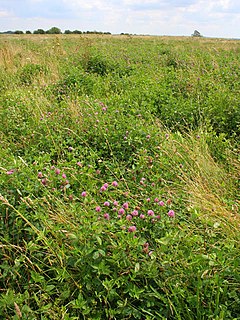
In agriculture, a green manure is a crop specifically produced to be incorporated into the soil while still green. Typically, the green manure's biomass is incorporated with a plow or disk, as is often done with (brown) manure. The primary goal is to add organic matter to the soil for its benefits. Green manuring is often used with legume crops to add nitrogen to the soil for following crops, especially in organic farming, but is also used in conventional farming.

Beneficial insects are any of a number of species of insects that perform valued services like pollination and pest control. The concept of beneficial is subjective and only arises in light of desired outcomes from a human perspective. In agriculture, where the goal is to raise selected crops, insects that hinder the production process are classified as pests, while insects that assist production are considered beneficial. In horticulture and gardening, beneficial insects are often considered those that contribute to pest control and native habitat integration.
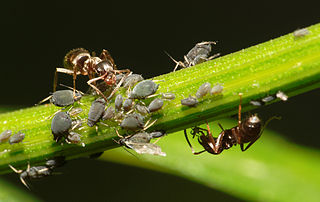
Protocooperation is where two species interact with each other beneficially; they have no need to interact with each other - they interact purely for the gain that they receive from doing this. It is not at all necessary for protocooperation to occur; growth and survival is possible in the absence of the interaction. The interaction that occurs can be between different kingdoms.

Organic horticulture is the science and art of growing fruits, vegetables, flowers, or ornamental plants by following the essential principles of organic agriculture in soil building and conservation, pest management, and heirloom variety preservation.

The soil food web is the community of organisms living all or part of their lives in the soil. It describes a complex living system in the soil and how it interacts with the environment, plants, and animals.
Biopesticides, a contraction of 'biological pesticides', include several types of pest management intervention: through predatory, parasitic, or chemical relationships. The term has been associated historically with biological pest control – and by implication, the manipulation of living organisms. Regulatory positions can be influenced by public perceptions, thus:
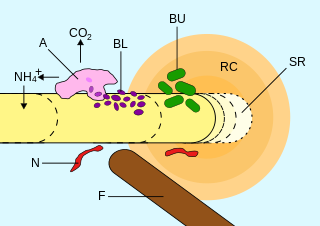
The rhizosphere is the narrow region of soil or substrate that is directly influenced by root secretions and associated soil microorganisms known as the root microbiome. The rhizosphere involving the soil pores contains many bacteria and other microorganisms that feed on sloughed-off plant cells, termed rhizodeposition, and the proteins and sugars released by roots, termed root exudates. This symbiosis leads to more complex interactions, influencing plant growth and competition for resources. Much of the nutrient cycling and disease suppression by antibiotics required by plants, occurs immediately adjacent to roots due to root exudates and metabolic products of symbiotic and pathogenic communities of microorganisms. The rhizosphere also provides space to produce allelochemicals to control neighbours and relatives.
Ecological facilitation or probiosis describes species interactions that benefit at least one of the participants and cause harm to neither. Facilitations can be categorized as mutualisms, in which both species benefit, or commensalisms, in which one species benefits and the other is unaffected. This article addresses both the mechanisms of facilitation and the increasing information available concerning the impacts of facilitation on community ecology.

A beneficial weed is an invasive plant that has some companion plant effect, is edible, contributes to soil health, adds ornamental value, or is otherwise beneficial. These plants are usually not domesticated, however, some invasive plants, such as dandelions, are commercially cultivated, in addition to growing in the wild. Beneficial weeds include many wildflowers, as well as other weeds that are commonly removed or poisoned.

The nematodes or roundworms constitute the phylum Nematoda, with plant-parasitic nematodes also known as eelworms. They are a diverse animal phylum inhabiting a broad range of environments. Less formally, they are categorized as Helminths, but are taxanomically classified along with arthropods, tardigrades and other moulting animals in the clade Ecdysozoa, and unlike flatworms, have tubular digestive systems with openings at both ends. Like tardigrades, they have a reduced number of Hox genes, but their sister phylum Nematomorpha has kept the ancestral protostome Hox genotype, which shows that the reduction has occurred within the nematode phylum.

Agricultural pollution refers to biotic and abiotic byproducts of farming practices that result in contamination or degradation of the environment and surrounding ecosystems, and/or cause injury to humans and their economic interests. The pollution may come from a variety of sources, ranging from point source water pollution to more diffuse, landscape-level causes, also known as non-point source pollution and air pollution. Once in the environment these pollutants can have both direct effects in surrounding ecosystems, i.e. killing local wildlife or contaminating drinking water, and downstream effects such as dead zones caused by agricultural runoff is concentrated in large water bodies.
Soil microbiology is the study of microorganisms in soil, their functions, and how they affect soil properties. It is believed that between two and four billion years ago, the first ancient bacteria and microorganisms came about on Earth's oceans. These bacteria could fix nitrogen, in time multiplied, and as a result released oxygen into the atmosphere. This led to more advanced microorganisms, which are important because they affect soil structure and fertility. Soil microorganisms can be classified as bacteria, actinomycetes, fungi, algae and protozoa. Each of these groups has characteristics that define them and their functions in soil.

The Celebrity tomato cultivar is a hybrid (biology) that produces long fruit-bearing stems holding 20 or more very plump, robust tomatoes. Fruits weigh approximately 8 oz., and are 4 inches across. Plants need caging or staking, and produce fruit throughout the growing season. The celebrity tomato is a cultivar of the species Solanum lycopersicum. It is a crossbreed of the common tomato that is widely used for various culinary purposes. This tomato is of great size and is known to be resistant to most tomato diseases such as Fusarium wilt, Verticillium wilt, Tobacco mosaic virus and Root-knot nematode due to its hybrid nature. Celebrity tomatoes are highly adaptive to harsh environments and can grow in a wide range of places including dry, humid and wet regions. They are resistant to cracking and splitting which usually occurs when there is an excess of water and sugar movement in the fruits. Therefore, causing the tomato skin to grow at a slower rate compared to the expansion of the fruit. They can survive in harsh uneven rainfall. However, they are highly susceptible to colder environments and are at a higher risk of dying in regions with short growing seasons. The plants can grow up to 5 feet in height with bright red medium-sized fruits. The plants are generally very thick and grow in clusters. The tomato fruits are mostly used in the making of various salsas, salads, juices and canned food.
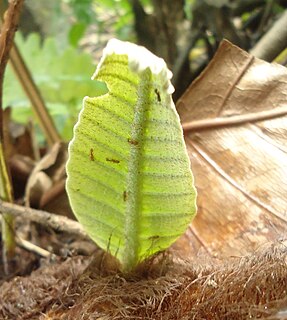
Tritrophic interactions in plant defense against herbivory describe the ecological impacts of three trophic levels on each other: the plant, the herbivore, and its natural enemies. They may also be called multitrophic interactions when further trophic levels, such as soil microbes, endophytes, or hyperparasitoids are considered. Tritrophic interactions join pollination and seed dispersal as vital biological functions which plants perform via cooperation with animals.
Korean natural farming (KNF) is an organic agricultural practice that takes advantage of indigenous microorganisms (IMO) to produce fertile soils that yield high output without the use of herbicides or pesticides. A result is an improvement in soil health, improving loaminess, tilth and structure, and attracting large numbers of earthworms. KNF also enables odour-free hog and poultry farming without the need to dispose of effluent.














